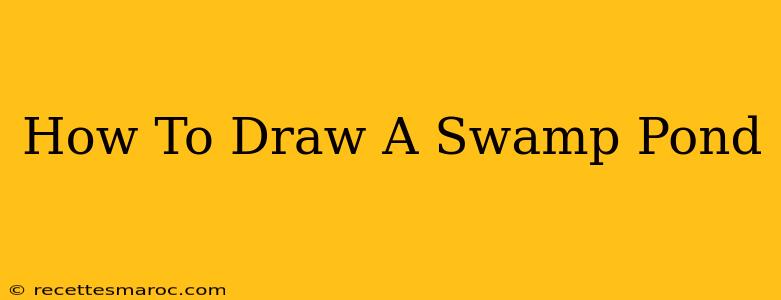So you want to learn how to draw a swamp pond? Whether you're a seasoned artist or just picking up a pencil for the first time, capturing the unique atmosphere of a swampy pond requires understanding its key elements. This guide will walk you through the process, from sketching basic shapes to adding intricate details. Let's dive in!
Understanding the Essence of a Swamp Pond
Before we start drawing, let's consider what makes a swamp pond unique. Think about:
- Still, Murky Water: Unlike a clear stream, swamp water tends to be dark and still, often reflecting the surrounding vegetation.
- Lush Vegetation: Expect an abundance of plants, including reeds, lilies, cypress trees (especially in southern swamps), and other water-loving flora.
- Wildlife: Consider adding animals like frogs, turtles, snakes, dragonflies, and various birds.
- Muddy Banks: The edges of the pond are often muddy and uneven, not clean and defined.
- Atmospheric Mood: Swamps often evoke a feeling of mystery and stillness, sometimes even a touch of eeriness.
These elements will inform our drawing choices and help create a believable swamp pond scene.
Step-by-Step Drawing Process
Step 1: Basic Shapes and Layout
- Sketch the Pond: Start with a rough outline of the pond’s shape. Swamps don't have perfectly shaped ponds; they're usually irregular. Use curved lines to depict a natural, uneven shoreline.
- Define the Banks: Lightly sketch the muddy banks around the pond. They should be uneven and possibly slightly overgrown.
- Add Vegetation Zones: Indicate general areas where different plants will grow. Think about where reeds might cluster densely, and where lilies might float on the surface.
Step 2: Adding Details to the Water
- Water Texture: Don't just draw a flat surface. Use subtle shading to suggest depth and stillness. Darker areas can represent deeper parts of the pond, while lighter areas can be shallows.
- Reflections: Lightly sketch reflections of the surrounding vegetation in the water. These don't need to be perfect mirror images; subtle reflections add realism.
- Lily Pads: Add lily pads scattered across the surface. Vary their sizes and orientations for a natural look.
Step 3: Incorporating Vegetation
- Reeds and Rushes: Draw tall reeds and rushes along the edges of the pond. Use long, thin lines to depict their stems, with feathery tops.
- Trees and Shrubs: Depending on your swamp type, add cypress trees or other appropriate swamp-loving trees and shrubs to the background. Use varied line weights and textures to give them depth.
- Other Plants: Include other swamp plants like water lilies (with their flowers), cattails, and any other flora appropriate to the type of swamp you’re depicting.
Step 4: Adding Wildlife (Optional)
- Choose Your Creatures: Select a few animals to populate your swamp. Frogs, turtles, snakes, and dragonflies are all common swamp inhabitants.
- Realistic Positioning: Place the animals in believable locations within the scene. For example, a frog might sit on a lily pad, while a snake might coil near the bank.
- Detailed Renderings: Add details to your animals to bring them to life. Consider their textures and colors.
Step 5: Finishing Touches and Shading
- Refine Lines: Go over your sketch with a darker pencil to refine the lines and shapes.
- Add Shading: Use shading to create depth and dimension. Focus on the shadows created by the vegetation and the unevenness of the banks.
- Background: Add a background to set the scene. This could be a forest, more swamp, or even a hazy sky.
Tips for Success
- Use Reference Images: Looking at photographs of real swamp ponds will provide invaluable inspiration and help you accurately depict the details.
- Experiment with Textures: Don't be afraid to experiment with different pencil techniques to create varied textures in your drawing.
- Practice Makes Perfect: The more you draw, the better you'll become at capturing the essence of a swamp pond.
By following these steps and incorporating your own creative flair, you can create a captivating drawing of a swamp pond. Remember to have fun and let your imagination run wild! Happy drawing!

